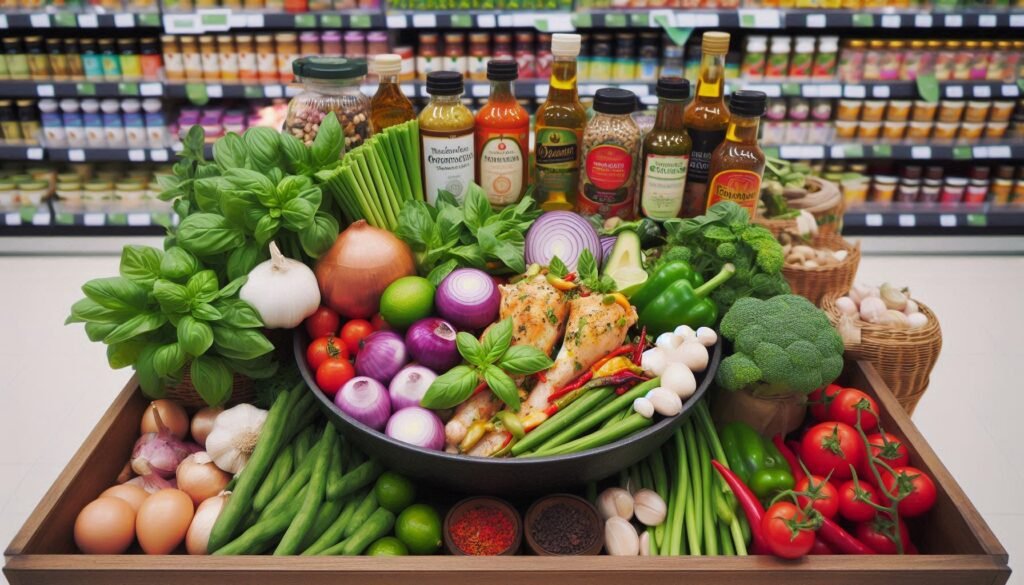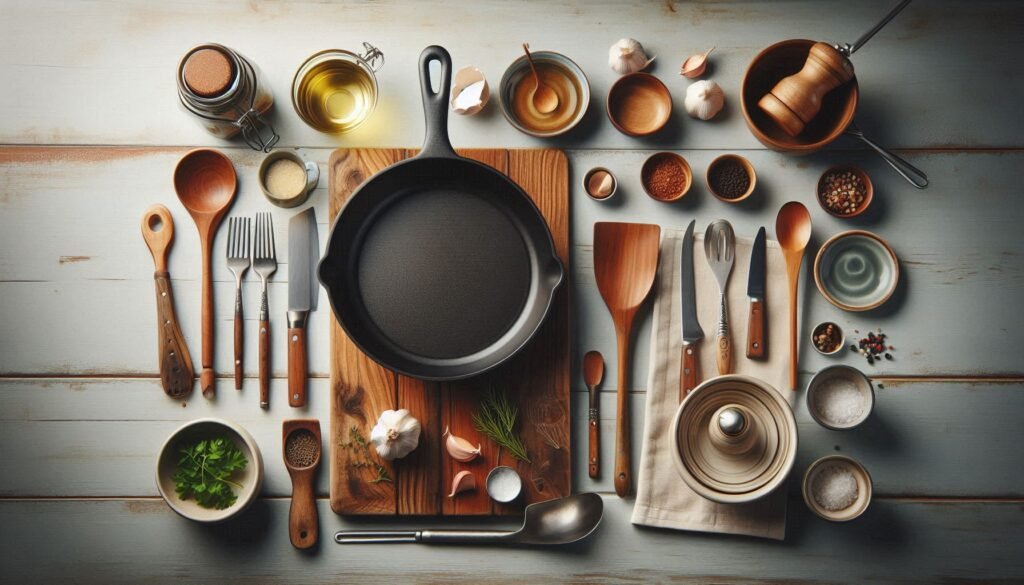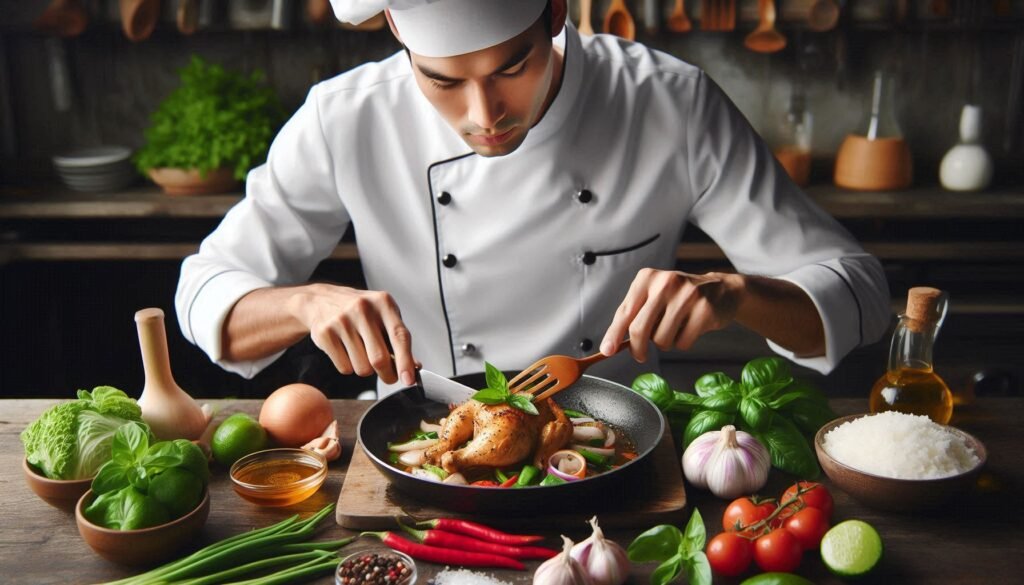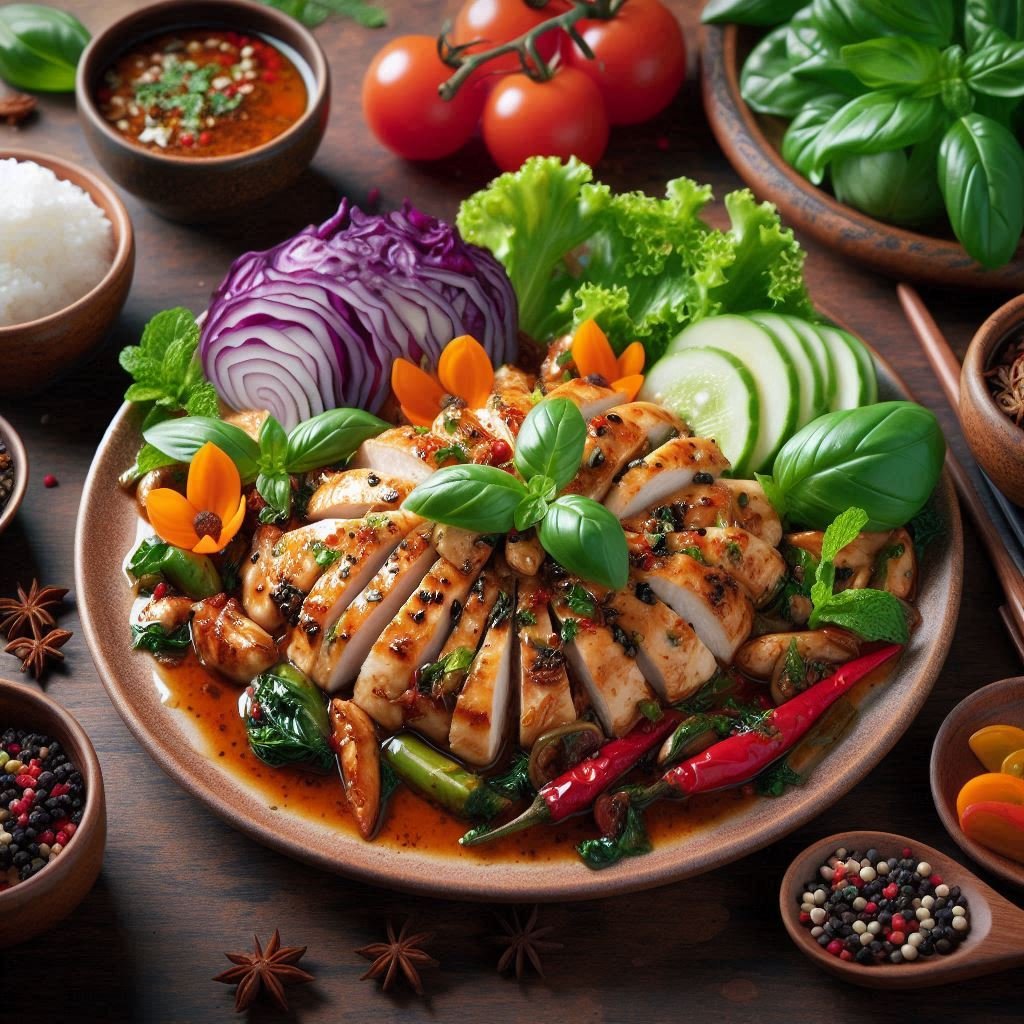Thai Basil Chicken, known as Pad Krapow Gai, is a beloved Thai dish that combines aromatic herbs, savory flavors, and the comforting essence of home-cooked meals. This dish is quick to prepare, making it perfect for busy weeknights when you crave something flavorful yet simple. With just a few ingredients, you can bring a taste of Thailand to your dinner table in under 30 minutes!
History of the Thai Basil Chicken Dish
Pad Krapow Gai is a staple in Thai street food culture, known for its bold flavors and aromatic basil. The name “Pad Krapow” translates to “stir-fried with holy basil,” highlighting the dish’s essential ingredient. This dish is typically enjoyed in bustling markets and food stalls across Thailand, where it is often served with a side of rice and a fried egg on top. The use of holy basil (also known as Thai basil) adds a unique peppery flavor that sets it apart from other basil varieties, making it an iconic representation of Thai culinary heritage.
Thai Basil Chicken Dish Ingredients
For the Chicken Stir-Fry:
- 1 lb (450g) ground chicken (or diced chicken breast)
- 2 tablespoons vegetable oil
- 4 cloves garlic, minced
- 2 Thai red chilies, sliced (adjust for spice preference)
- 1 tablespoon soy sauce
- 1 tablespoon oyster sauce
- 1 tablespoon fish sauce
- 1 teaspoon sugar
- 1 cup fresh Thai basil leaves
For Serving:
- Cooked jasmine rice
- Fried eggs (optional)
- Lime wedges (optional)

Thai Basil Chicken Dish Price Estimate
As of 10/27/2024 for a couple living in the USA
- Ground Chicken: $4.00
- Vegetable Oil: $0.50
- Garlic: $0.50
- Thai Red Chilies: $0.50
- Soy Sauce: $0.20
- Oyster Sauce: $0.30
- Fish Sauce: $0.30
- Sugar: $0.10
- Thai Basil: $2.00
- Jasmine Rice: $1.00 (for 2 servings)
- Fried Eggs: $1.00 (optional)
Total Estimated Cost: $10.90 (approximately $5.45 per serving for 2 serving
What tools are necessary to cooking the Thai Basil Chicken Dish?
To make Thai Basil Chicken (Pad Krapow Gai), you’ll need a few basic kitchen tools:
Required Cooking Tools
- Wok or Large Skillet: Ideal for stir-frying at high heat and evenly distributing flavors. A non-stick skillet works well if a wok is unavailable.
- Cutting Board: For chopping the chicken, vegetables, and basil.
- Chef’s Knife: Sharp enough to finely chop the ingredients.
- Garlic Press or Mortar & Pestle: Optional but useful for mincing garlic and crushing chilis for a more authentic flavor.
- Mixing Spoon or Spatula: For stirring ingredients and keeping them moving in the pan.
- Measuring Spoons/Cups: To measure sauces and seasonings accurately.
- Small Bowl: For mixing sauces before adding them to the pan.
- Serving Plate or Bowl: To serve the finished dish.
Optional Tools
- Rice Cooker: Perfect for preparing jasmine rice, a traditional side for Thai basil chicken.
- Tongs: Helpful for flipping chicken pieces, though a spatula also works fine.
Having these tools ready will make cooking faster and help maintain the high heat necessary for stir-frying. Let me know if you need further tips on cooking or equipment!

Thai Basil Chicken Dish Cooking Instructions
- Heat the Oil: In a large skillet or wok, heat the vegetable oil over medium-high heat.
- Sauté Garlic and Chilies: Add the minced garlic and sliced chilies to the pan, stirring until fragrant, about 30 seconds.
- Cook the Chicken: Add the ground chicken to the skillet, breaking it up with a spatula. Cook until it’s browned and cooked through, about 5-7 minutes.
- Add Sauces and Sugar: Stir in the soy sauce, oyster sauce, fish sauce, and sugar. Mix well to combine and let it cook for an additional 2-3 minutes.
- Add Basil: Remove the skillet from heat and fold in the fresh Thai basil leaves until wilted.
- Serve: Serve the Thai Basil Chicken over jasmine rice, topped with a fried egg if desired. Add lime wedges for an extra burst of flavor.
Tips for Perfect Thai Basil Chicken
- Customize the Spice Level: Adjust the number of chilies based on your heat preference. For a milder version, remove the seeds before adding.
- Use Fresh Ingredients: Fresh Thai basil is key to achieving authentic flavor. If unavailable, sweet basil can be used as a substitute, though the taste will differ slightly.
- Meal Prep Option: This dish stores well, making it great for meal prep. Prepare a larger batch and reheat for lunches or quick dinners.
Variations for even better taste
- Vegetarian Option: Substitute ground chicken with crumbled tofu or tempeh for a vegetarian version.
- Add Vegetables: Incorporate bell peppers, green beans, or snap peas for added nutrition and color.

Nutrition Information of a Thai Basil Chicken meal (per serving)
- Calories: 350
- Protein: 28g
- Fat: 20g
- Carbohydrates: 20g
Thai Basil Chicken is a vibrant, flavorful dish that is sure to impress your family and friends. With its bold flavors and quick cooking time, it’s a fantastic choice for anyone looking to explore the delicious world of Thai cuisine. Try this recipe today and enjoy a culinary journey right from your kitchen!
Amend the Thai Basil Chicken meal to be More Diabetic Friendly
Thai Basil Chicken (Pad Krapow Gai) can be modified to be more diabetic-friendly, though the traditional recipe may need some adjustments depending on individual dietary needs.
Key Considerations for Diabetic-Friendly Modifications:
- Carbohydrate Content:
- Traditional Pad Krapow Gai often includes white jasmine rice, which can cause blood sugar spikes due to its high glycemic index. To make it more suitable for a diabetic diet, consider serving it with brown rice, cauliflower rice, or a smaller portion of jasmine rice.
- Sauces and Sugar:
- Thai recipes typically use a combination of oyster sauce, soy sauce, and fish sauce, sometimes with added sugar. The sugar content in oyster sauce and added sugar can be high, so you might want to use low-sugar or sugar-free alternatives. For example, opt for low-sodium soy sauce and use a small amount of a natural sweetener like stevia if sweetness is desired.
- Lean Protein:
- Chicken breast is a great choice as it is lean and has minimal impact on blood sugar. For a more diabetic-friendly version, stick with breast meat rather than thigh meat, which can be higher in fat.
- Vegetable Content:
- Adding more non-starchy vegetables, like bell peppers, green beans, or zucchini, can increase the fiber content, which helps slow down carbohydrate absorption and improve blood sugar control.
This is not a medical advice – As with any meal, portion control and monitoring blood glucose after eating are important to assess individual tolerance. Consulting with a registered dietitian or healthcare provider can help tailor the recipe to specific diabetic needs
Potential Allergens of the Thai Basil Chicken
For Thai Basil Chicken (Pad Krapow Gai), here are common allergens to be aware of, especially if catering to people with food sensitivities or allergies:
Potential Allergens
- Soy:
- Soy sauce is typically used in the recipe, which can be problematic for those with soy allergies. A soy-free alternative could be coconut aminos, which provides a similar flavor without soy.
- Gluten:
- Soy sauce often contains wheat, making this dish non-gluten-free. Gluten-free tamari sauce or certified gluten-free soy sauce can be used as substitutes.
- Fish (Fish Sauce):
- Fish sauce is a classic ingredient in Thai cooking and gives Pad Krapow Gai its authentic flavor. Those allergic to fish can omit it or use vegan fish sauce alternatives, though this will alter the flavor slightly.
- Shellfish (Possible Cross-Contamination in Fish Sauce):
- Some brands of fish sauce are manufactured in facilities that also process shellfish. Check labels to ensure there’s no cross-contamination risk if someone has a shellfish allergy.
- Garlic and Chili:
- While not common allergens, garlic and chili peppers can cause issues for people with sensitivities. Omitting or reducing these ingredients can make the dish gentler on the stomach.
- Sesame (if used as a garnish):
- Some variations of Pad Krapow Gai are garnished with sesame seeds or oil, which could be a concern for those with sesame allergies.
Allergy-Friendly Modifications
For an allergy-friendly version, use coconut aminos instead of soy sauce, gluten-free tamari for wheat sensitivity, and omit fish sauce for fish allergies. For garlic and chili sensitivities, adjust the amount or consider alternative seasonings
This is not a medical advice and you should always consult your doctor

Best Occasions for the Thai Basil Chicken Dish
hai Basil Chicken is a versatile dish that works well for several occasions due to its quick prep and vibrant flavors. Here are some ideal times to cook this meal:
1. Weeknight Dinner
- Why: It’s quick, flavorful, and requires minimal ingredients, making it perfect for busy evenings.
- Bonus: You can easily double the recipe for leftovers the next day.
2. Lunch Meal Prep
- Why: The dish reheats well, so preparing a large batch on Sunday and storing it in meal-prep containers provides delicious lunches all week.
- Bonus: Pair it with jasmine rice and a few steamed veggies for a complete, balanced meal.
3. Family Weekend Lunch
- Why: It’s easy to customize spice levels and ingredients, making it family-friendly. Plus, it brings a unique flavor to the table without taking up too much time.
- Bonus: Serve with a side of fried eggs and lime wedges for added texture and freshness.
4. Dinner Party with Friends
- Why: Its exotic flavors are crowd-pleasing, and it’s easy to make in large quantities. Guests will appreciate the taste of authentic Thai food, especially when served with other Asian-inspired side dishes.
- Bonus: Present it with fresh Thai basil leaves as a garnish for added flair.
5. Quick Post-Workout Meal
- Why: The dish is protein-packed and nutritious, perfect for a post-workout meal that fuels you without being too heavy.
- Bonus: Customize by adding extra veggies or a side of brown rice for additional fiber.
These flexible options make Thai Basil Chicken a go-to recipe for various occasions, from quick weeknight dinners to special gatherings!.
A Story of the Thai Basil Chicken
Thai Basil Chicken, or Pad Krapow Gai, carries a rich story rooted in Thai street food culture. It’s said to have originated from the need for a quick, satisfying meal that could be cooked up fast and enjoyed on the go, just like you might find in bustling Thai street markets. The combination of ground chicken, garlic, chilies, and holy basil makes this dish uniquely fragrant and bursting with flavors that instantly transport diners to Thailand.
There’s a popular saying in Thailand that if you can’t decide what to order, “just get Pad Krapow,” because it’s universally beloved and reliably tasty at any food stall or restaurant. Thai workers often grab this meal during a quick lunch break, enjoying it with a fried egg on top (kai dao), which adds richness and texture to the dish. The fried egg is often punctured so the yolk drips over the spicy, savory chicken and rice, creating an irresistible mix of flavors and textures.
The use of holy basil, or “krapow” in Thai, is significant, as this variety of basil is revered not only for its peppery, slightly spicy flavor but also for its cultural importance. Holy basil is seen as a sacred herb in Thailand, associated with health and wellness. Many locals believe it brings balance to the body, which makes Pad Krapow a meal that’s both delicious and deeply symbolic.
This dish has become so popular that it’s now a staple in homes and restaurants worldwide. But no matter where it’s made, one taste of authentic Thai Basil Chicken often inspires a sense of comfort and connection to Thailand’s vibrant street food heritage.
Call to Action
Love this recipe? Share your results with us! Tag us on social media or leave a comment below to let us know how your Thai Basil Chicken turned out!



